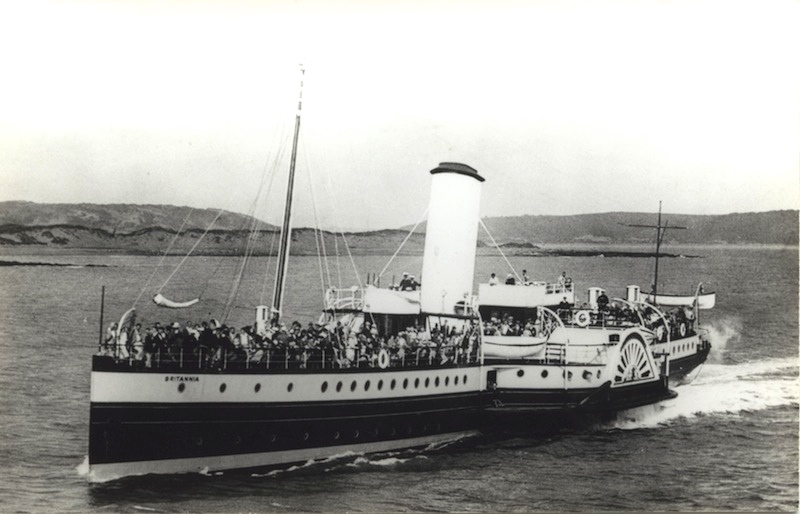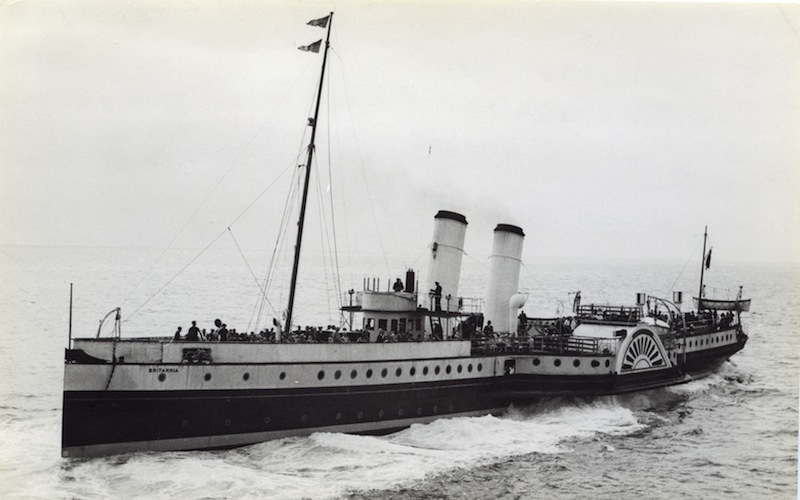Stuart Cameron reflects on the Clyde connections of one of the Bristol Channel’s longest-lived and most popular paddlers.
This is an unusual combination of ship and location. Although originally built on the Clyde, at Samuel McKnight’s shipbuilding yard in Ayr in 1896, the paddle steamer Britannia was owned throughout her 60-year career by the famous Bristol Channel excursion steamer operators P. and A. Campbell, a family firm with origins on the Clyde. Peter and Alec Campbell had sold the goodwill of their Scottish business to the Caledonian Railway in 1888 but maintained their Clyde connection for the rest of their lives.
Britannia was mainly associated with the firm’s Bristol-Ilfracombe service but also participated in their south coast operations. She is known to have made occasional return visits to the Clyde, one of the most unusual being in 1901 when she undertook a trip with passengers for the Glasgow International Exhibition. She was advertised to sail on June 6 from Bristol (9.15am), Cardiff, Penarth and Mumbles, arriving at Gourock early the following morning. She ran excursions to Rothesay on the 7th and 8th, proceeding on each day to see yacht races, and returned south via the Kyles of Bute on the 11th, arriving back at Bristol the following day after lunch. The trip was limited to 200 passengers, for whom onboard sleeping accommodation was provided.
She also returned to Clydeside for winter refit. Following Admiralty service during the First World War (when, as HMS Britain, she was present at the surrender of the German fleet at Scapa Flow), Britannia was extensively refitted at Harland & Wolff’s Govan shipyard in 1919. Less than a year later, in October 1920, she returned to Glasgow for reboilering at A. & J. Inglis’ Pointhouse yard (this firm having become a subsidiary of Harland & Wolff three years earlier).
It was at the start of the latter visit that the picture above was taken, showing the steamer berthed at Clyde Place Quay on the south side of the river, just downstream from the Glasgow Central Station railway bridge. She had departed from Bristol on Thursday 14 October, arriving in Glasgow the next day and remaining at this berth until the following Monday, when she moved to Inglis’ fitting out quay at the mouth of the River Kelvin.
The location of this photograph has previously been incorrectly identified as ‘Bridge Wharf’. That name did not come into use until almost nine years later, in May 1929, when river steamer services were relocated from the Broomielaw on the north bank of the river to Bridge Wharf on the south side. By that time Clyde Place Quay had been removed to make way for the new King George V road and pedestrian bridge.
Inglis completed Britannia’s reboilering by December 1920 but the ship did not return immediately to the Bristol Channel. In fact she sailed only as far as Bowling Harbour where she was laid up (on December 8) for the remainder of the winter in the company of some of the Clyde steamer fleet.
When Britannia returned to the Clyde for a second reboilering in 1935, this time at Barclay Curle’s Elderslie Dockyard (March 8-April 4), the opportunity was taken to improve her accommodation and fit a new, large, flat-sided funnel. She called at Gourock and Blairmore on the afternoon of April 5, departing the latter pier at 2.40pm and sailing direct to Hotwells Landing Stage at Bristol, which she reached at 6.45pm on the 6th.
That was Britannia’s last visit to the waters of her birth, but when she was reboilered for a third time, at Cardiff in 1948, the new double-ended, oil-fired Scotch boiler was ordered from Fairfields and transported by road from Govan. On this occasion her appearance was transformed again with the fitting of two funnels forward of the paddle-boxes.
At the time of her withdrawal in 1956 Britannia was still one of Campbells’ most popular steamers.
Catch up will all CRSC’s previous posts by clicking on News & Reports.















